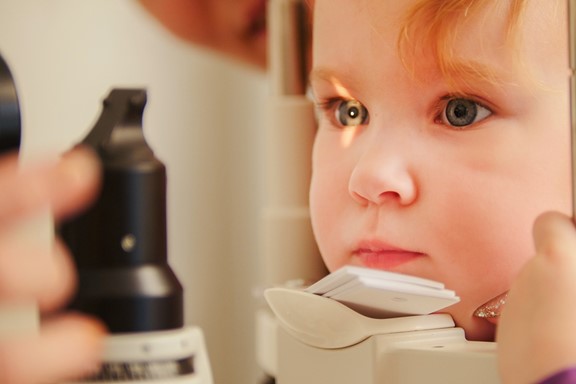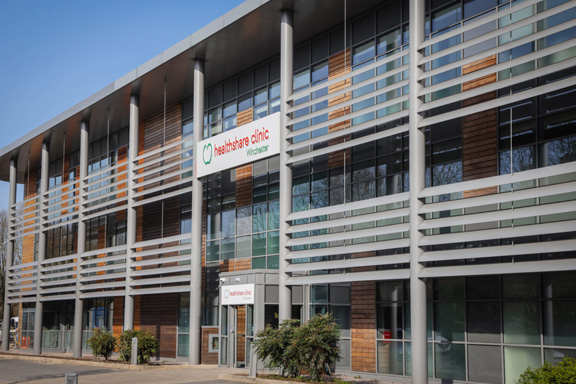Glaucoma in Children
The eye is like a ball. It pumps itself up with a watery fluid (aqueous humour) made by a part of the eye called the ciliary body. This is a ring of tissue just behind the coloured part of the eye (iris). Aqueous humour flows from this ring of tissue through the gap in the iris (pupil) into the front portion of the eye. The clear window in the front portion of the eye is called the cornea, and is like a transparent dome. A filter system runs right around the base of the dome in the ‘drainage angle’.
The aqueous humour flows out through this filter system into a collector channel called Schlemm’s canal and then into the blood vessels around the outside of the eye.
It is the resistance of the filter system that determines the pressure in the eye. In the vast majority of children with glaucoma, the pressure goes up in the eye because this drainage system does not work properly.

Primary congenital glaucoma
This is the most common type of glaucoma in babies and small children. The normal filter system in the eye does not develop as it should, and as a result the aqueous humour does not flow out of the eye properly and the pressure in the eye (IOP) rises.
Many cases of this type of glaucoma may run in families and specific advice on the chances of inheritance should be sought from an expert (genetic counsellor) with up to date knowledge.
Secondary glaucomas
Axenfeld’s or Reiger’s Anomaly
These conditions are named after the doctors who first described them. In this type of glaucoma, apart from the problem with the development of the filter system, there are usually abnormalities in the development of the iris and sometimes in parts of the cornea. In addition there can be changes in the shape of the teeth, face, ears and other parts of the body, although these changes may not be present.
There is a significant chance of developing glaucoma, and patients with Axenfeld’s or Reiger’s Anomalies need to have regular check-ups for life.
Peter’s Anomaly
In this condition there are abnormalities in the lens and cornea of the eye. Sometimes the lens of the eye may be attached to the cornea. Glaucoma may develop and further treatment, such as surgery, may be required.
Other types of glaucoma
Glaucoma often follows cataract surgery in babies and children. If the lens of the eye becomes cloudy, this is called a cataract and may require surgery. The reason for the development of glaucoma after cataract surgery is still not entirely clear.
Glaucoma can also occur if the eye becomes inflamed for any reason, such as in children who have the childhood form of arthritis, as the filter system may get blocked with inflammatory cells.
Glaucoma can sometimes occur in children with other conditions such as aniridia, in which there is no, or very little, development of the iris.
Glaucoma can also occur in Sturge Weber syndrome; these patients also have a blood vessel birth mark on the face, particularly the forehead, known as a port wine stain. Children with these physical signs need to be monitored for the development of glaucoma and treated if necessary.
Signs & symptoms in children
Large eyes
The outer coat (sclera) of a child’s eye is much softer and more flexible than that of an adult. As a result, if the pressure rises in the eye, the eye expands rather like a balloon being blown up. This enlarged eye size is one of the important indicators of raised eye pressure in a baby or young child.
Reducing the pressure does not usually bring the eye back to its normal size but may reduce the size of the eye very slightly.
Some parents of children with glaucoma report how people have tended to remark on what lovely large eyes their child has.
Sensitivity to light
Children with raised IOP often become very sensitive to light. There may be several causes for this. The clear window of the eye (cornea) may be slightly waterlogged and cloudy, which can be uncomfortable. When the cornea is not absolutely clear, light bounces off the cornea irregularly and causes glare. It will not harm the child’s vision in the short term to wear dark glasses, particularly in bright lighting conditions. Even after the pressure is lowered, some degree of sensitivity to light may persist in the long term.
Cloudy eyes
The cornea has a sheet of little cells on the inside which pump aqueous humour out of the cornea, keeping it clear. If the pressure rises sufficiently, aqueous humour is pushed into the cornea, making it waterlogged and cloudy. If the cornea expands, small cracks may occur on the inside of the cornea and this may also cause partial clouding. The clouding clears when the pressure is reduced but this may sometimes take several months.
Watering eyes
Watering is a natural response to any form of irritation of the eyes. If the eye pressure is high, and if there is glare from lights and also some swelling of the cornea, then the natural reflex will be watering of the eyes. This should improve when the pressure in the eye is controlled.
Poor vision and jerky eyes
Occasionally, if raised pressure in the eye has caused clouding of the cornea or pressure on the optic nerve head (the small hole where all the nerves leave at the back of the eye), vision may be poorer than usual and there may also be movements of the eye. After treatment, most of these symptoms improve.
Squint (strabismus)
In some children the eye with poorer vision may be seen to turn inwards, towards the nose, or outwards.
Glaucoma in families
The majority of glaucoma in children is not obviously inherited. Families with a history of childhood glaucoma should consult a genetic counsellor or specialist in children’s glaucoma regarding the possibility of inheritance.
FAQs
When a baby or young child develops glaucoma they are often miserable, and this is one of the concerns that first alerts the family and doctors to the problem. The baby may be crying a lot and feeding poorly, and the eye is red and watery. The baby is particularly upset by bright lights and may try to bury its head in the pillow. The colour of the eye may seem.
For the front of the eye to stay healthy, it needs the moisture of tears. Tears contain natural antibiotics. Forming a lot of tears when a baby cries does no damage.
Obviously a severe blow to the head could cause injury to any child and if there is any concern, seek a doctor’s advice immediately.
Minor knocks and bumps are a normal course of events in any toddler’s life, but an enlarged eye is more fragile than a normal eye. If there is sudden marked change in the vision or the eye looks cloudy, has blood inside or if the eye is causing the child pain, then seek medical advice immediately. If a child with glaucoma receives a hard knock directly on the eye (rather than on the head or face) then they should be examined by an eye specialist without delay.
If the eye has become greatly enlarged then it may easily be damaged by a direct blow. If this is the case, rough sports such as rugby are inadvisable.
Protective glasses are available for ball sports, and are especially recommended for playing squash.
In some cases, for example if your child has recently had eye surgery (especially if it is a trabeculectomy), you may be advised not to allow them to swim for some time in order to avoid infection.
Any sports or activities which require the head in a downward position, should be avoided.
Quality care in a relaxing surrounding
Book an appointment to see Mr Nish Srikantha at the Candover clinic in Basingstoke, or the Healthshare Clinic in Winchester.
Both locations are modern purpose built private hospitals designed entirely for patient well-being and comfort. The Candover Clinic is a stand-alone unit located on the Basingstoke and North Hampshire Hospital. The Healthshare Clinic on the outskirts of Winchester boasts a purpose built ophthalmic outpatients department and operating theatre offering the latest diagnostic and treatment technologies.













